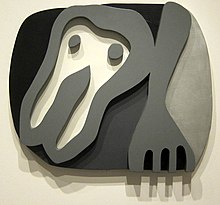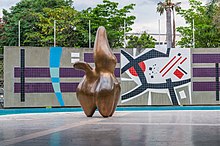
Jean Arp
Quick Facts
Biography
Jean Arp or Hans Arp (16 September 1886 – 7 June 1966) was a German-French sculptor, painter, poet, and abstract artist in other media such as torn and pasted paper.
Early life
Arp was born in Strasbourg, the son of a French mother and a German father, during the period following the Franco-Prussian War when the area was known as Alsace-Lorraine (Elsass-Lothringen in German) after France had ceded it to (Germany) in 1871. Following the return of Alsace to France at the end of World War I, French law determined that his name become Jean. Arp would continue referring to himself as "Hans" when he spoke German.
In 1904, after leaving the École des Arts et Métiers in Strasbourg, he went to Paris where he published his poetry for the first time. From 1905 to 1907, Arp studied at the Kunstschule in Weimar, Germany, and in 1908 went back to Paris, where he attended the Académie Julian. Arp was a founder-member of the Moderne Bund in Lucerne, participating in their exhibitions from 1911 to 1913.
In 1912, he went to Munich, called on Wassily Kandinsky, the influential Russian painter and art theorist, was encouraged by him in his researches and exhibited with the Der Blaue Reiter group. Later that year, he took part in a major exhibition in Zürich, along with Henri Matisse, Robert Delaunay and Kandinsky. In Berlin in 1913, he was taken up by Herwarth Walden, the dealer and magazine editor who was at that time one of the most powerful figures in the European avant-garde.
In 1915, he moved to Switzerland to take advantage of Swiss neutrality. Arp later told the story of how, when he was notified to report to the German consulate in Zurich, he pretended to be mentally ill in order to avoid being drafted into the German Army: after crossing himself whenever he saw a portrait of Paul von Hindenburg, Arp was given paperwork on which he was told to write his date of birth on the first blank line. Accordingly, he wrote "16/9/87"; he then wrote "16/9/87" on every other line as well, then drew one final line beneath them and, "without worrying too much about accuracy", calculated their sum. Hans Richter, describing this story, noted that "they [the German authorities] believed him."
Career

In 1916, Hugo Ball opened the Cabaret Voltaire, which was to become the center of Dada activities in Zurich for a group that included Arp, Marcel Janco, Tristan Tzara, and others. In 1920, as Hans Arp, along with Max Ernst and the social activist Alfred Grünwald, he set up the Cologne Dada group. However, in 1925, his work also appeared in the first exhibition of the surrealist group at the Galérie Pierre in Paris.
In 1926, Arp moved to the Paris suburb of Meudon. In 1931, he broke with the Surrealist movement to found Abstraction-Création, working with the Paris-based group Abstraction-Création and the periodical, Transition. Beginning in the 1930s, the artist expanded his efforts from collage and bas-relief to include bronze and stone sculptures. He produced several small works made of multiple elements that the viewer could pick up, separate, and rearrange into new configurations.

Throughout the 1930s and until the end of his life, he wrote and published essays and poetry. In 1942, he fled from his home in Meudon to escape German occupation and lived in Zürich until the war ended.
Arp visited New York City in 1949 for a solo exhibition at the Buchholz Gallery. In 1950, he was invited to execute a relief for the Harvard University Graduate Center in Cambridge, Massachusetts and would also be commissioned to do a mural at the UNESCO building in Paris.
Exhibitions

In 1958, a retrospective of Arp's work was held at the Museum of Modern Art in New York City, followed by an exhibition at the Musée National d'Art Moderne, Paris, France, in 1962. Organized by the Minneapolis Institute of Arts and the Wurttembergischer Kunstverein of Stuttgart, a 150-piece exhibition titled "The Universe of Jean Arp" concluded an international six-city tour at the San Francisco Museum of Modern Art in 1986.
The Musée d'art moderne et contemporain of Strasbourg houses many of his paintings and sculptures.
Recognition
Arp's career was distinguished with many awards including the Grand Prize for sculpture at the 1954 Venice Biennale, a sculpture prizes at the 1964 Pittsburgh International, the 1963 Grand Prix National des Arts, the 1964 Carnegie Prize, the 1965 Goethe Prize from the University of Hamburg, and then the Order of Merit with a Star of the German Republic.
Personal life and death
Arp and his first wife, the artist Sophie Taeuber-Arp, became French nationals in 1926. In the 1930s, they bought a piece of land in Clamart and built a house at the edge of a forest. Influenced by the Bauhaus, Le Corbusier and Charlotte Perriand, Taeuber designed it. She died in Zürich in 1943. After living in Zürich, Arp was to make Meudon his primary residence again in 1946.
Arp married the collector Marguerite Hagenbach (1902–1994), his long-time companion, in 1959. He died in 1966, in Basel, Switzerland.
Quotes of the artist
- - "I hereby declare that on February 8th, 1916, Tristan Tzara discovered the word Dada. I was present with my twelve children...and I wore a brioche in my left nostril. I am convinced that this word has no importance and that only imbeciles and Spanish professors can be interested in dates. What interests us is the Dada spirit and we were all Dada before the existence of Dada.." [from Arp's 'Declaration', October 1921]
- - "Art is fruit growing out of man like the fruit out of a plant like the child out of the mother...Reason tells man to stand above nature and to be the measure of all things....through reason man became a tragic and ugly figure.." [c. 1932]
- - "These paintings, these sculptures – these objects – should remain anonymous, in the great workshop of nature, like the clouds, the mountains, the seas, the animals, and man himself. Yes! Man should go back to nature! Artists should work together like the artists of the Middle Ages." [c. 1941–42]
- -"Sculpture should walk on the tips of its toes, unostentatious, unpretentious, and light as the spoor of an animal in snow. Art should melt into and even merge with nature itself. This is obviously contrary to painting and sculpture based on nature. By so doing, art will rid itself more and more of self-centredness, virtuosity and absurdity." [in 'Arp on Arp', 1958]
- -"I allow myself to be guided by the work which is in the process of being born, I have confidence in it [Arp refers to 'automatic creation'. I do not think about it. The forms arrive pleasant, or strange, hostile, inexplicable, mute, or drowsy. They are born from themselves. It seems to me as if all I do is move my hands.[1960's]
Legacy
There are three Arp foundations in Europe: The Fondation Arp in Clamart preserves the atelier where Arp lived and worked for most of his life; about 2,000 visitors tour the house each year. The Fondazione Marguerite Arp-Hagenbach in Locarno, Switzerland, was founded by Arp's second wife, Marguerite Arp-Hagenbach. A foundation dedicated to Arp, named Stiftung Hans Arp und Sophie Taeuber-Arp e.V., was established in 1977 by the dealer Johannes Wasmuth in consultation with Marguerite Arp-Hagenbach and owns the largest collection of works by Arp and holds the copyright of all his works. It has research centre and office in Berlin, and an office in Rolandseck, Germany.